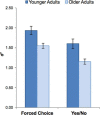Declines in representational quality and strategic retrieval processes contribute to age-related increases in false recognition
- PMID: 28530412
- PMCID: PMC5729965
- DOI: 10.1037/xlm0000412
Declines in representational quality and strategic retrieval processes contribute to age-related increases in false recognition
Abstract
In a Yes/No object recognition memory test with similar lures, older adults typically exhibit elevated rates of false recognition. However, the contributions of impaired retrieval, relative to reduced availability of target details, are difficult to disentangle using such a test. The present investigation sought to decouple these factors by comparing performance on a Yes/No (YN) test to that on a Forced Choice (FC) test, which minimizes demands on strategic retrieval processes, enabling a more direct measure of the availability of object details. Older adults exhibited increased lure false recognition across test formats (Experiment 1), suggesting a decline in the availability of object details contributes to deficits in performance. Manipulating interference by varying the number of objects studied selectively enhanced performance in the FC test, resulting in matched performance across groups, whereas age differences in YN performance persisted (Experiment 2), indicating an additional contribution of impaired strategic retrieval. Consistent with differential sensitivity of test format to strategic retrieval and the quality of stimulus representations among older adults, variability in the quality of object representations, measured using a perceptual discrimination task, was selectively related to FC performance. In contrast, variability in memory control processes, as measured with tests of recall and executive function, was related to performance across test formats. These results suggest that both declines in the availability of object details and impaired retrieval of object details contribute to elevated rates of lure false recognition with age, and highlight the utility of test format for dissociating these factors in memory-impaired populations. (PsycINFO Database Record
(c) 2017 APA, all rights reserved).
Figures




References
-
- Badre D., & Wagner A. D. (2007). Left ventrolateral prefrontal cortex and the cognitive control of memory. Neuropsychologia, 45, 2883–2901. - PubMed
-
- Brainerd C. J., & Reyna V. F. (2002). Fuzzy-trace theory and false memory. Current Directions in Psychological Science, 11, 164–169. 10.1111/1467-8721.00192 - DOI
MeSH terms
Grants and funding
LinkOut - more resources
Full Text Sources
Other Literature Sources
Medical

